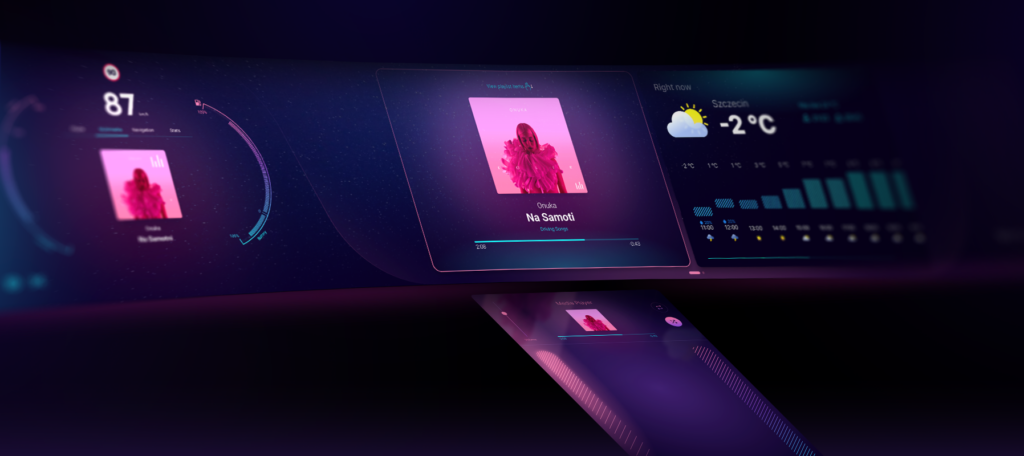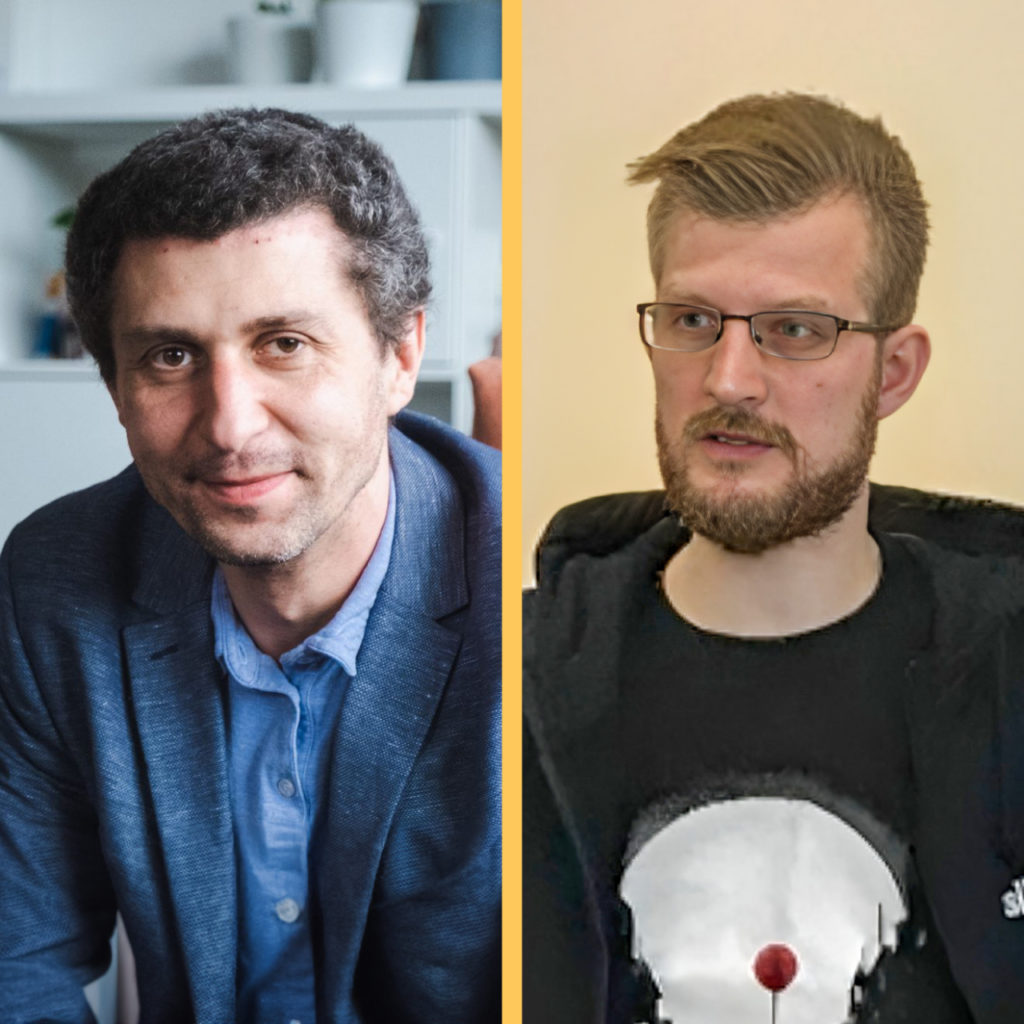Dojo initiative: Wavey, a gesture-controlled IVI system
A driver should be focused on hitting the right road exit, not on hitting the petrol station pin on the cockpit screen with their finger. To make using in-car services and applications more convenient and enjoyable, we have set ourselves the challenge of creating Wavey – a next-generation digital cockpit hardware and software platform.
What is Wavey, and why have we decided to create it?
IVI (In-vehicle infotainment) screens have become more and more extensive. Some of them take up almost the entire front dashboard of the car. We assumed that handling such a large area must be quite troublesome for a driver. Hence the idea of controlling the car system with gestures without taking eyes off the road was developed.
Wavey is an IVI system that is operated not from the large screen but from an external tablet located between the seats at an angle of about 30 degrees.
We aimed to create a complex HMI in the software-defined vehicle (SDV) era. In this area, there is a strong focus on low-level and hardware; we wanted to stand against and provide a great product presentation as well.
Another objective was to use proven platforms and tools without compromising the brands’ visual identity, keeping the possibility of customisation and creation of a unique user interface.
And because above it all stood the desire to deepen existing knowledge and acquire new skills around automotive-HMI, we decided to launch the project as an initiative within Dojo.
When someone asks what Dojo is, I like to say that it’s a purpose-based R&D. It’s a space where we create projects dictated by business and technology needs. We carry out initiatives that arise from market demands, which are also interesting for our employees and boost their competencies. Thus, we prepare ourselves for ambitious client projects. We often present the results of our work within the Dojo at conferences or industry events.
Marieta Węglicka, CTO at Spyrosoft Synergy, Head of Dojo Vision Crew
Wavey at CES 2023
CES – Consumer Electronic Show – is the most influential tech event in the world, organised annually by the Consumer Technology Association in Las Vegas. It’s a space for presenting new technologies, innovative prototypes, and breakthrough products.
The project demo was a part of the Qt Company’s exhibition space during CES 2023, as a demonstration of the framework’s possibilities, as well as our specialists’ skills. It attracted a lot of attention to the booth during demo walkthroughs. The feedback we received was all positive, and many people said that Wavey addressed real-life use cases.
A peek under the hood. Wavey’s architecture, UX, and hardware
In terms of design, we wanted to validate the idea of gesture control in a large cockpit in a car. The interface had to be intuitive and clear-cut to keep the driver focused on the road. We used Qt technology, as it’s a good framework for creating such complex projects. We implemented a microHMI architecture on the backend to maintain more flexibility in the development process. Each team was feature-based, independent of others that worked in the same cockpit domain. Creating such a structure was very complex and very interesting at the same time.
Marieta Węglicka, CTO at Spyrosoft Synergy, Head of Dojo Vision Crew

Hardware
We used the Qualcomm SA8155P – a 7nm system-on-chip (SoC) designed for automotive solutions as the underlying hardware. It enables the creation of IVI systems; supports surround-view monitoring, advanced audio integration and additional communications such as WLAN or WWAN integration. Qualcomm SA8155P was designed with a variety of operating systems in mind, including Android Automotive or QNX Hypervisor, both used by us in the project.
To deploy the Wavey system, we used 41″ wide-bar screen as the main cockpit, 15” touch panel as the source of interaction.
MicroHMI architecture
Wanting to create a workflow in which we could work independently on the different system modules, we planned a microHMI-based architecture.
Like microservices, this architecture consists of isolated human-machine interfaces that can be independently created, tested, deployed, and updated.
Breaking the monolith into atomic fragments allowed us to build prototypes easily, verify ideas fast, and maintain a high pace of development of a single-car cockpit, as one team didn’t have to wait for others to implement changes in their modules. Cracking the dependencies between teams is crucial while developing the SDV on scale. After testing that approach during the Wavey project, we’ve introduced those learnings, practices, and architectural patterns into other customer projects, not just those in the automotive industry.
Android Automotive
Waveys is built on top of Android Automotive 11 OS. The platform has mature middleware services, a rich Google applications ecosystem, and vast third-party integration possibilities (i.a., with media or messaging apps).
We aimed to prove that one can take full advantage of Android Automobile capabilities while, where possible, not having much of an Android look. We wanted to avoid a generic UI and let brands maintain their image over the car cockpit system while discovering new User Experience patterns.
Qt components
This Dojo initiative is also the fruit of a partnership with The Qt Company.
Qt is a set of cross-platform libraries and SDKs (software development kits) for C++, QML and Java programming languages. Its framework and tools enable designing UIs, developing applications, and deploying software more conveniently.
As we wanted to excel in our knowledge of Qt, we employed it as a core technology for Wavey. We used the following components:
- Qt Interface Framework,
- Qt Application Manager,
- and Qt for Android Automotive.
Why do we partner with QT?
The Qt Company is a global software firm with a strong presence in over 70 industries and is the leading independent technology behind millions of devices and applications. Qt is used by major international companies and developers worldwide, and the technology enables its customers to deliver exceptional user experiences and advance their digital transformation initiatives.
Since 2022, we’ve partnered with The Qt Company to enhance technology development by stimulating and supporting each other’s Qt activities. The partnership involves sharing business opportunities and workload related to customer enquiries, aiming to achieve and increase mutual commercial benefits, better utilisation of technology and offering improved services to the Qt user community.
Bring innovation to life with Spyrosoft
Do you have an HMI project in mind? We can support you on the way from the idea to a full-functioning product. Here you’ll find more information about the scope of our services: Build Human Machine Interfaces with synergy in mind.
We’re looking forward to working with you.
About the author
Our blog












